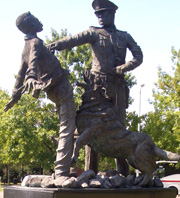Statements By Buildings
NOVEMBER 8, 2008

- Alabama civil rights movement monument
- (Les Lovoy)
- View the Slideshow
Web Resources
Related Stories
We've got a new president and some new members of Congress. But don't forget the third branch of government: The Supreme Court is in session. This week, justices heard arguments for and against "fleeting expletives" on television, without hearing any expletives. Next week, the justices will hear another First Amendment case: Summum v. Pleasant Grove City. Pleasant Grove, Utah has the Ten Commandments in its public square - something the Supreme Court has already ruled legal. But now the Summum, a religious group, want to put their "Seven Aphorisms" next to the Ten Commandments. They say the government can't pick and choose religions to sanctify, and that monuments are "government speech." This got us thinking about all the things monuments have to say around the country. We start off in Boise, Idaho.
---
Adam Cotterell in Boise, Idaho: In front of the capitol building, there's a large metal statue, green-flaked with corrosion, and on the plaque it reads: "Frank Steunenberg, governor of Idaho, 1897 to 1900. When in 1899 organized lawlessness challenged the power of Idaho, he upheld the dignity of the state and forced its authority and restored law and order within its boundaries, for which he was assassinated in 1905. Rugged in body, resolute in mind, massive in the strength of his convictions, he was of the granite hewn. In grateful memory of his courageous devotion to public duty, the people of Idaho have erected this monument."
Rebecca Sheir in Boston, Mass.: "On January 15, 1919, a molasses tank at 529 Commercial Street exploded under pressure, killing 21 people. A 40-foot wave of molasses buckled the elevated railroad tracks, crushed buildings, and inundated the neighborhood. Structural defects in the tank, combined with unseasonably warm temperatures, contributed to the disaster." I'm surprised! I shouldn't laugh. It's tragic. But when you think about death in some sort of accident, industrial or otherwise, rarely do you associate that with molasses.
Sarah McCammon in Lincoln, Neb.: This is like a sort of a sheltered bus stop with a roof over it, and the words are actually printed right around the edge of this roof. So I'm going to have to walk around here to read it. But I will. "It may be said I am in height six feet four inches" - now I'm turning a corner - "nearly. Lean in flesh, weighing on an average one hundred and eighty pounds. Dark complexion" - another corner there - "with coarse black hair and gray eyes. No other marks or brands recollected. A. Lincoln. 12/20/1859."
Rene Gutel in Tempe, Ariz.: I'm on the campus of Arizona State University in one of their academic buildings. There's a giant mural here, with a bunch of Native Americans painted against a yellow background. The Native Americans are in pairs. There's two of them side by side, and there's four sets. And they have these big rattlesnakes in their mouths that they're just like holding and chomping onto. And there's an inscription that reads, "Man's wisdom subdues the aggressive forces of nature." I didn't really understand what this is all about until I saw a tiny, tiny little plaque that read that this is to commemorate ASU's role in producing rattlesnake anti-venom.
Les Lovoy in Birmingham, Ala.: I'm standing in Kelly Ingram Park, which is directly across the street from the Civil Rights Institute here in Birmingham and the Baptist church which was bombed in the 1960s, which killed the four little African-American young ladies who were getting ready for church that day. I'm standing in front of a statue of a Caucasian police officer holding on to a black young man, with a German shepherd off its chain getting ready to attack this young man. "This sculpture is dedicated to the foot soldiers of the American Civil Rights movement. With gallantry, courage, and great bravery, they faced the violence of attack dogs, high-powered water hoses, and bombings. They were the fodder in the advance against injustice, warriors of a just cause. They represent humanity unshaken in their firm belief in their nation's commitment to liberty and justice for all. We salute these men and women who were the soldiers of this great cause."
Blair Chavis in Chicago, Ill.: When most people think of memorials they think of wars, or commemorating veterans. But on Chicago's North Side, there is an entire park devoted to "The Wizard of Oz" and its creator. If you look around the yellow brick road, which is the entranceway to the park, you'll see several memorials or dedications that people have purchased on single bricks that are on this yellow brick road. There's a brick on the further end of the entrance that says, "Lynn, I love you. Will you marry me? Brad. 9/13/96." And the brick just adjacent to it says, "Yes, sweetheart. L."
-
- Music Bridge:
- Trick
- Artist: Rainstick Orchestra
- CD: The Floating Glass Key in The Sky (Ninja Tune)







Comments
Comment | Refresh
Post a Comment: Please be civil, brief and relevant.
Email addresses are never displayed, but they are required to confirm your comments. All comments are moderated. Weekend America reserves the right to edit any comments on this site and to read them on the air if they are extra-interesting. Please read the Comment Guidelines before posting.
You must be 13 or over to submit information to American Public Media. The information entered into this form will not be used to send unsolicited email and will not be sold to a third party. For more information see Terms and Conditions and Privacy Policy.